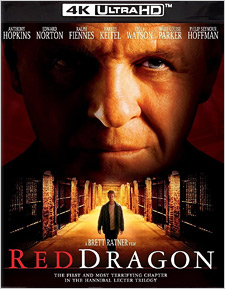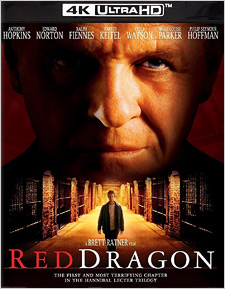Red Dragon (4K UHD Review)

Director
Brett RatnerRelease Date(s)
2002 (October 24, 2023)Studio(s)
Universal Pictures (Kino Lorber Studio Classics)- Film/Program Grade: B
- Video Grade: A+
- Audio Grade: A+
- Extras Grade: A-
Review
For longtime fans of Michael Mann’s Manhunter (plenty lot of alliteration there), it seemed almost like heresy to tackle Thomas Harris’ novel of Red Dragon once more for the big screen. Yet, it was almost inevitable after the Academy Award-winning success of The Silence of the Lambs and its box office juggernaut follow-up Hannibal, both having an enormous impact on popular culture and firmly entrenching Anthony Hopkins’ portrayal of Hannibal Lecter as one of the greatest screen villains of all time. Matters weren’t helped by the choice of director, Brett Ratner, who had proven himself to be a successful commercial director-for-hire, but wasn’t popular among film fans. Nevertheless, the Dino De Laurentiis team, along with returning screenwriter Ted Tally who had adapted The Silence of the Lambs, helped persuade Anthony Hopkins to reprise the role of Hannibal Lecter one last time. The results were mostly positive, and with a lucrative box office take, it was clear that the public was hungry for more Hannibal... though the debate rages on as to which is the better adaptation of the source material: Manhunter or Red Dragon.
Considered a prequel film at the time of its release, Red Dragon was originally the first novel to feature the Hannibal Lecter universe of characters. Because of this, there was mild confusion some among audience members as to when exactly this story took place (my own Mother among them). Prior to the events of The Silence of the Lambs, we see FBI agent Will Graham (Edward Norton) working alongside close friend and forensic psychiatrist Hannibal Lecter (Anthony Hopkins), but suddenly realizing that Hannibal is the killer he’s been trying to profile. Lecter attempts to kill Will, but he manages to subdue him and survive the attack, retiring from police work after Lecter is tried and convicted of multiple counts of murder and cannibalism. Will’s old boss, Jack Crawford (Harvery Keitel), lures him back to work many years later, insisting that he help profile the serial killer dubbed by the press as “The Tooth Fairy.” Aware that the killer is working on a lunar cycle, Crawford and his men are desperate to find stop him, leaving Will no choice but to help, even at the disapproval of his wife (Mary-Louise Parker). In order to catch the killer, Will must once again face Lecter for his insight while avoiding tabloid reported Freddie Lounds (Philip Seymour Hoffman). Meanwhile, the Tooth Fairy—Francis Dolarhyde (Ralph Fiennes)—is planning his next murder while simultaneously developing a romance with a blind co-worker, Reba (Emily Watson), who’s unaware of the monster lurking beneath Dolarhyde.
Though the film version of Red Dragon adds more material to its narrative, it’s a surprisingly more faithful version of the original novel, right down to its ending. Interestingly, both Manhunter and Red Dragon share the same cinematographer, Dante Spinotti, yet look entirely different from each other, lacking many of Manhunter’s aggressive visual trappings, including color lighting gels and frequent low angles. As the film is a precursor to The Silence of the Lambs, it’s also more in tune with that film continuity-wise, even bringing back Dr. Chilton (Anthony Heald) and Barney (Frankie Faison), the latter of whom appeared in all of the Hannibal Lecter films (aside from Hannibal Rising). Most people who dislike Manhunter also accuse it of basically being a predecessor stylistically to Miami Vice, which in many ways it is, though one might argue that William Petersen’s Will Graham is a more effective portrayal of the character; someone who’s disturbed and dealing with having to being inside the mind of a killer, but also having to navigate turning that part of his brain off when the investigation is over. On the other hand, Manhunter lacks the subtext and backstory given to Francis Dolarhyde in the original novel, which the film version of Red Dragon takes full advantage of. On the other hand, Red Dragon also adds a rather pointless epilogue of sorts that attempts to tie directly into The Silence of the Lambs, despite the timeline of events as previously seen in that film not really matching up.
In truth, there are certainly many pros and cons to both Manhunter and Red Dragon, and neither of them are perfect adaptations of the material. Which is the more effective will most definitely boil down to personal taste, and while this writer prefers Manhunter over Red Dragon, one can’t deny that Red Dragon has its share of strong moments and performances. It’s a very good film that shows a surprising amount of restraint and attention to detail, and it’s certainly the best film that Brett Ratner has ever made, though that’s partly in thanks to Ted Tally’s excellent screenplay. It’s also very distinct visually. You have to hand it to Dante Spinotti for approaching the same material in an entirely new way and still making it look interesting. At the end of the day, there are four roads into the world of Red Dragon: the original novel, Manhunter, this film, and the Hannibal TV series, which finally got into the Francis Dolarhyde storyline in the show’s third and final season (though to a less than successful degree, in my opinion).
Red Dragon was shot by director of photography Dante Spinotti on 35 mm film using Panavision Panaflex Millennium cameras; Panavision Primo, C-, and E-Series lenses; finished photochemically; and presented in the aspect ratio of 2.39:1. Kino Lorber Studio Classics brings the film to UHD from a new master taken from a 4K scan of the original camera negative, graded for High Dynamic Range (HDR10 and Dolby Vision options are available), and presented on a BD-100 disc. The film was shot primarily on medium speed, fine grain film stock (Kodak Vision 200T 5274, with 500T 5279 seamlessly mixed in), allowing for an extremely even-keeled grain structure, which Kino’s new UHD faithfully re-creates. This is a highly organic presentation that’s sharp with an exceeding amount of fine detail. It’s also clean with nary a speck of damage leftover and a comfortably suitable bitrate that gets the most out of shadows and night scenes without sacrificing detail during brighter moments. The film features a very specific color palette, giving many scenes a cool or sickly look, while others appear more natural. Moments that take place outside of Lecter’s and Dolarhyde’s surroundings can often be rich with lovely greens and reds, while the interiors of Dolarhyde’s home offer deep shadows, rich browns, and deep blacks. Contrast is perfect, and the HDR grades manage to soak up every last detail in the color palette. In essence, it’s a gorgeous presentation, and sets the highest bar for the film on home video.
Audio is included in English 5.1 and 2.0 DTS-HD Master Audio with optional subtitles in English SDH. Red Dragon is not a film that requires a vast amount of surround activity, per se, but the 5.1 mix nonetheless fills the space up nicely, allowing for subtle ambient moments, as well as explosive ones. Dialogue is king here, as it should be, and it’s perfectly discernible at all times, including those moments when Danny Elfman’s score gets a bit too bombastic (for my taste, anyway). There’s also plenty of low end lift to be had. The alternate stereo experience is a fine alternative for those without access to a multi-channel setup. It’s doubtful that a 7.1 or Atmos upgrade could do much better. Like the video portion of this presentation, the audio soars.
Red Dragon on 4K Ultra HD sits in a black amaray case alongside a 1080p Blu-ray containing the film and the bulk of the bonus materials. The insert and slipcover both use the artwork from the original theatrical poster (as have most home video releases of the film). The following extras are included on each disc:
DISC ONE (UHD)
- Audio Commentary by Brett Ratner and Ted Tally
- Isolated Score with Audio Commentary by Danny Elfman
DISC TWO (BD)
- Audio Commentary by Brett Ratner and Ted Tally
- Isolated Score with Audio Commentary by Danny Elfman
- A Director’s Journey: The Making of Red Dragon (SD – 39:28)
- Inside Red Dragon (SD – 14:20)
- Red Dragon: Visual Effects (SD – 4:26)
- Red Dragon: Screen and Film Tests (SD – 11:44)
- Anthony Hopkins: Lecter & Me (SD – 4:25)
- Freddie on Fire (SD – 4:01)
- Leeds House Crime Scene (SD – 3:38)
- Makeup Application (SD – :46)
- Inside the Mind of a Killer with John Douglas, FBI Profiler (SD – 8:17)
- Red Dragon: Film to Storyboard Comparison (SD – 4 scenes in all – 8:39)
- Brett Ratner’s Student Film (SD – 3:37)
- Deleted Scenes with Optional Commentary (SD – 7 in all – 5:24)
- Alternate Scenes with Optional Commentary (SD – 4 in all – 4:34)
- Extended Scenes (SD – 3 in all – 2:29)
- Trailer (HD – 2:06)
- The Silence of the Lambs Trailer (HD – 1:52)
- Hannibal Trailer (HD – 2:19)
There are no new extras included on this release, but (nearly) everything from the previous DVD and Blu-ray releases has carried over. Missing are a set of text-based Lecter FBI notes and the film’s full theatrical trailer, only the teaser is included. Otherwise, all relevant material is present and accounted for. The audio commentary with Brett Ratner and Ted Tally is surprisingly informative and interesting, providing a wealth of behind-the-scenes information without ever going off the rails. Also included is an isolated score track interspersed with occasional commentary by Danny Elfman, though one might’ve simply preferred an isolated score track or a straight commentary, or both. Nevertheless, Elfman periodically (though abruptly) tells of his musical approach for the film. The rest of the extras are quite extensive, going into the making of the film, but also providing a look at the deleted scenes, as well as a short student film by Brett Ratner. It’s not necessarily relevant to the main subject, but its inclusion is welcome regardless.
In the years since its release, I think many (including myself) have warmed up to Red Dragon more, realizing that while not perfect, there’s plenty here worth appreciating. Kino Lorber’s UHD upgrade is quite stellar and presents the film in a new light for all to appreciate. It comes highly recommended and is well worth a revisit.
- Tim Salmons
(You can follow Tim on social media at these links: Twitter and Facebook. And be sure to subscribe to his YouTube channel here.)

